3D-ASL脑灌注成像技术临床应用及研究进展
- 格式:ppt
- 大小:4.25 MB
- 文档页数:30
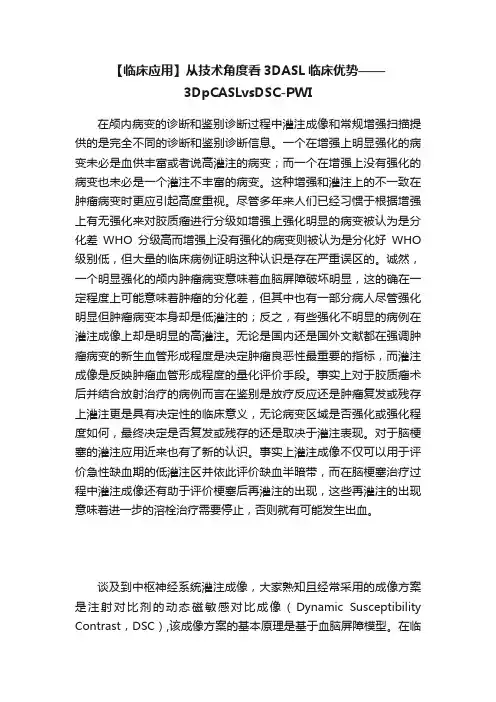
【临床应用】从技术角度看3DASL临床优势——3DpCASLvsDSC-PWI在颅内病变的诊断和鉴别诊断过程中灌注成像和常规增强扫描提供的是完全不同的诊断和鉴别诊断信息。
一个在增强上明显强化的病变未必是血供丰富或者说高灌注的病变;而一个在增强上没有强化的病变也未必是一个灌注不丰富的病变。
这种增强和灌注上的不一致在肿瘤病变时更应引起高度重视。
尽管多年来人们已经习惯于根据增强上有无强化来对胶质瘤进行分级如增强上强化明显的病变被认为是分化差WHO分级高而增强上没有强化的病变则被认为是分化好WHO 级别低,但大量的临床病例证明这种认识是存在严重误区的。
诚然,一个明显强化的颅内肿瘤病变意味着血脑屏障破坏明显,这的确在一定程度上可能意味着肿瘤的分化差,但其中也有一部分病人尽管强化明显但肿瘤病变本身却是低灌注的;反之,有些强化不明显的病例在灌注成像上却是明显的高灌注。
无论是国内还是国外文献都在强调肿瘤病变的新生血管形成程度是决定肿瘤良恶性最重要的指标,而灌注成像是反映肿瘤血管形成程度的量化评价手段。
事实上对于胶质瘤术后并结合放射治疗的病例而言在鉴别是放疗反应还是肿瘤复发或残存上灌注更是具有决定性的临床意义,无论病变区域是否强化或强化程度如何,最终决定是否复发或残存的还是取决于灌注表现。
对于脑梗塞的灌注应用近来也有了新的认识。
事实上灌注成像不仅可以用于评价急性缺血期的低灌注区并依此评价缺血半暗带,而在脑梗塞治疗过程中灌注成像还有助于评价梗塞后再灌注的出现,这些再灌注的出现意味着进一步的溶栓治疗需要停止,否则就有可能发生出血。
谈及到中枢神经系统灌注成像,大家熟知且经常采用的成像方案是注射对比剂的动态磁敏感对比成像(Dynamic Susceptibility Contrast,DSC),该成像方案的基本原理是基于血脑屏障模型。
在临床实际工作中这种灌注成像方案面临很多挑战,稍后我们将予以讨论。
另一个中枢神经系统灌注成像解决方案是动脉自旋标记技术(Artery Spin Labeling,ASL),这种方案采用动脉血中的水分子作为内源性示踪剂,不依赖于血脑屏障。
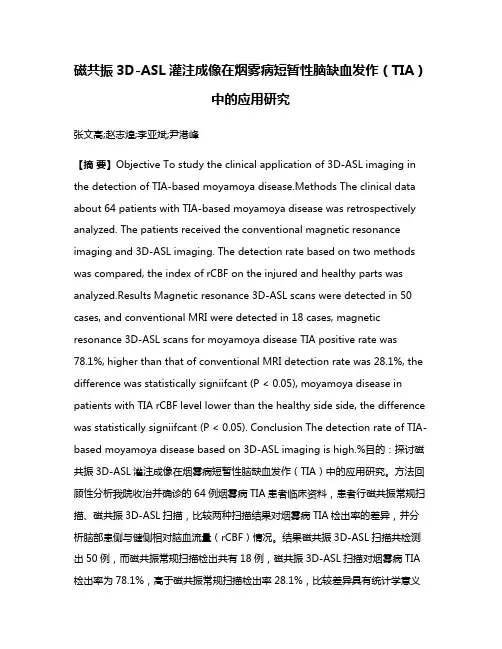
磁共振3D-ASL灌注成像在烟雾病短暂性脑缺血发作(TIA)中的应用研究张文高;赵志煌;李亚斌;尹港峰【摘要】Objective To study the clinical application of 3D-ASL imaging in the detection of TIA-based moyamoya disease.Methods The clinical data about 64 patients with TIA-based moyamoya disease was retrospectively analyzed. The patients received the conventional magnetic resonance imaging and 3D-ASL imaging. The detection rate based on two methods was compared, the index of rCBF on the injured and healthy parts was analyzed.Results Magnetic resonance 3D-ASL scans were detected in 50 cases, and conventional MRI were detected in 18 cases, magnetic resonance 3D-ASL scans for moyamoya disease TIA positive rate was 78.1%, higher than that of conventional MRI detection rate was 28.1%, the difference was statistically signiifcant (P < 0.05), moyamoya disease in patients with TIA rCBF level lower than the healthy side side, the difference was statistically signiifcant (P < 0.05). Conclusion The detection rate of TIA-based moyamoya disease based on 3D-ASL imaging is high.%目的:探讨磁共振3D-ASL灌注成像在烟雾病短暂性脑缺血发作(TIA)中的应用研究。

磁共振3D-ASL成像在急性脑卒中患者综合治疗后转归预测中的应用研究作者:***来源:《中国医学创新》2023年第22期【摘要】目的:探討磁共振三维动脉自旋标记(3D-ASL)成像在急性脑卒中患者综合治疗后转归预测中的应用。
方法:选取2019年1月—2022年8月于萍乡市人民医院接受综合治疗的急性脑卒中患者70例,采用改良Rankin量表(mRS)评估患者治疗后转归情况,根据转归情况将患者分为良好组(n=41)及不良组(n=29)。
比较两组患者临床资料、3D-ASL影像学资料,分析急性脑卒中患者综合治疗后转归不良的影响因素。
结果:70例患者中综合治疗后转归良好患者41例,转归不良患者29例。
良好组与不良组性别比较,差异无统计学意义(P>0.05);良好组年龄低于不良组,高血压、高血脂、低灌注占比均低于不良组,局部脑血流量(rCBF)水平高于不良组,病灶部位单侧占比高于不良组,差异均有统计学意义(P<0.05)。
logistic回归分析结果显示低灌注[OR=1.517,95%CI(1.060,2.172)]是导致综合治疗后转归不良的独立危险因素,rCBF[OR=0.696,95%CI(0.514,0.941)]是影响综合治疗后转归的保护因素(P<0.05)。
rCBF及低灌注预测急性脑卒中患者综合治疗后转归的曲线下面积分别为0.691、0.780,95%CI分别为(0.568,0.814)、(0.667,0.893)(P<0.05)。
结论:3D-ASL成像可有效预测急性脑卒中患者综合治疗后转归情况,为后续治疗和护理干预提供指导。
【关键词】三维动脉自旋标记急性脑卒中综合治疗转归Application of Magnetic Resonance 3D-ASL Imaging in Outcome Prediction of Acute Stroke Patients after Multimodality Therapy/HE Xi. //Medical Innovation of China, 2023, 20(22): -126[Abstract] Objective: To explore the application of magnetic resonance three dimension arterial spin labeling (3D-ASL) imaging in outcome prediction of acute stroke patients after multimodality therapy. Method: A total of 70 patients with acute stroke who received multimodality therapy in Pingxiang People's Hospital from January 2019 to August 2022 were selected. The modified Rankin scale (mRS) was used to evaluate the outcome of the patients after therapy. According to the outcome, the patients were divided into a good group (n=41) and an adverse group (n=29). The clinical data and 3D-ASL imaging data of the two groups were compared, and the influencing factors of adverse outcome of acute stroke patients after comprehensive treatment were analyzed. Result: Among the 70 patients, 41 had good outcome and 29 had adverse outcome after comprehensive treatment. There was no significant difference in gender between good group and adverse group (P>0.05). The age of good group was lower than that of adverse group, the proportions of hypertension, hyperlipidemia and hypoperfusion were lower than those of adverse group, the level of regional cerebral blood flow (rCBF) was higher than that of adverse group,and the proportion of unilateral lesion site was higher than that of adverse group, the differences were statistically significant (P<0.05). logistic regression analysis showed that hypoperfusion [OR=1.517, 95%CI (1.060, 2.172)] was an independent risk factors for adverse outcome after multimodality therapy, and rCBF [OR=0.696, 95%CI (0.514, 0.941)] was a protective factor affecting the outcome after multimodality therapy (P<0.05). The area under the curve of rCBF and hypoperfusion predicted the outcome of patients with acute stroke after multimodality therapy respectively was 0.691, 0.780, 95%CI respectively was (0.568, 0.814) and (0.667,0.893)(P<0.05). Conclusion: 3D-ASL imaging can effectively predict the outcome of acutestroke patients after multimodality therapy, and provide guidance for follow-up therapy and nursing intervention.[Key words] 3D-ASL Acute stroke Multimodality therapy OutcomeFirst-author's address: Pingxiang People's Hospital, Jiangxi Province, Pingxiang 337000,Chinadoi:10.3969/j.issn.1674-4985.2023.22.029急性脑卒中是由于患者自身脑血管疾病直接或间接引起颅内动脉狭窄、闭塞或破裂而突发的脑血液循环障碍性疾病,以突然昏倒或眼口歪斜、口齿不清等为主要临床表现,好发于中老年群体[1]。
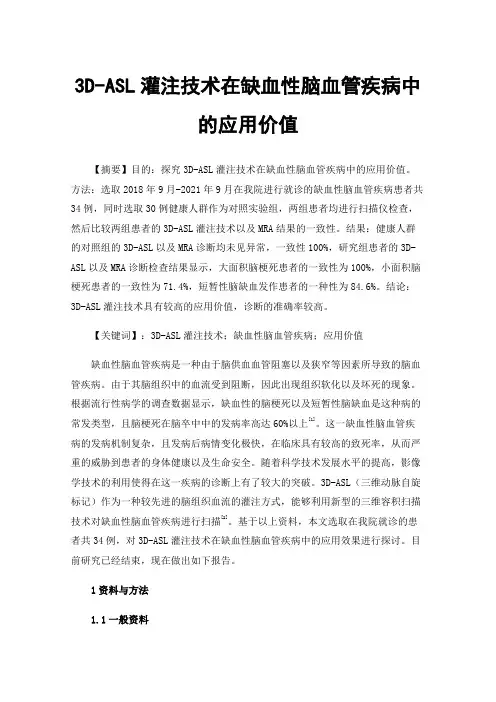
3D-ASL灌注技术在缺血性脑血管疾病中的应用价值【摘要】目的:探究3D-ASL灌注技术在缺血性脑血管疾病中的应用价值。
方法:选取2018年9月-2021年9月在我院进行就诊的缺血性脑血管疾病患者共34例,同时选取30例健康人群作为对照实验组,两组患者均进行扫描仪检查,然后比较两组患者的3D-ASL灌注技术以及MRA结果的一致性。
结果:健康人群的对照组的3D-ASL以及MRA诊断均未见异常,一致性100%,研究组患者的3D-ASL以及MRA诊断检查结果显示,大面积脑梗死患者的一致性为100%,小面积脑梗死患者的一致性为71.4%,短暂性脑缺血发作患者的一种性为84.6%。
结论:3D-ASL灌注技术具有较高的应用价值,诊断的准确率较高。
【关键词】:3D-ASL灌注技术;缺血性脑血管疾病;应用价值缺血性脑血管疾病是一种由于脑供血血管阻塞以及狭窄等因素所导致的脑血管疾病。
由于其脑组织中的血流受到阻断,因此出现组织软化以及坏死的现象。
根据流行性病学的调查数据显示,缺血性的脑梗死以及短暂性脑缺血是这种病的常发类型,且脑梗死在脑卒中中的发病率高达60%以上[1]。
这一缺血性脑血管疾病的发病机制复杂,且发病后病情变化极快,在临床具有较高的致死率,从而严重的威胁到患者的身体健康以及生命安全。
随着科学技术发展水平的提高,影像学技术的利用使得在这一疾病的诊断上有了较大的突破。
3D-ASL(三维动脉自旋标记)作为一种较先进的脑组织血流的灌注方式,能够利用新型的三维容积扫描技术对缺血性脑血管疾病进行扫描[2]。
基于以上资料,本文选取在我院就诊的患者共34例,对3D-ASL灌注技术在缺血性脑血管疾病中的应用效果进行探讨。
目前研究已经结束,现在做出如下报告。
1资料与方法1.1一般资料选取2018年9月-2021年9月在我院进行就诊的缺血性脑血管疾病患者共34例,同时选取30例健康人群作为对照实验组,按照自愿的原则参与本次研究,研究组患者34例,其中男性18例,女性16例,患者的平均年龄为62.49±3.86岁,其中大面积脑梗死患者8例,脑梗死患者17例,高血压病史患者16例,短暂性脑出血发作患者13例。
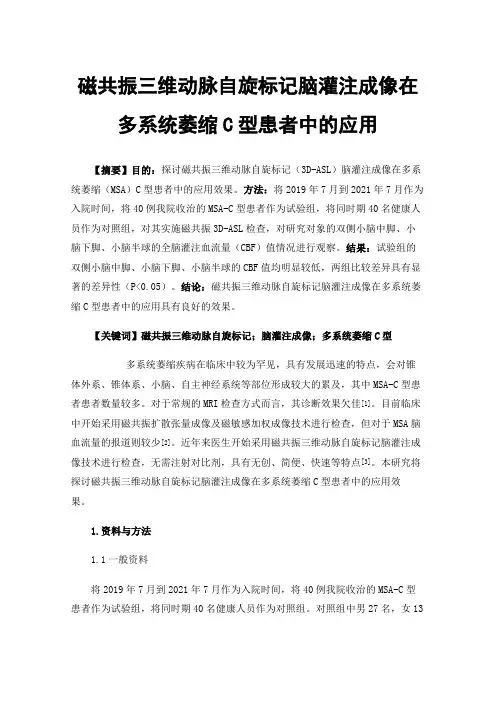
磁共振三维动脉自旋标记脑灌注成像在多系统萎缩C型患者中的应用【摘要】目的:探讨磁共振三维动脉自旋标记(3D-ASL)脑灌注成像在多系统萎缩(MSA)C型患者中的应用效果。
方法:将2019年7月到2021年7月作为入院时间,将40例我院收治的MSA-C型患者作为试验组,将同时期40名健康人员作为对照组,对其实施磁共振3D-ASL检查,对研究对象的双侧小脑中脚、小脑下脚、小脑半球的全脑灌注血流量(CBF)值情况进行观察。
结果:试验组的双侧小脑中脚、小脑下脚、小脑半球的CBF值均明显较低,两组比较差异具有显著的差异性(P<0.05)。
结论:磁共振三维动脉自旋标记脑灌注成像在多系统萎缩C型患者中的应用具有良好的效果。
【关键词】磁共振三维动脉自旋标记;脑灌注成像;多系统萎缩C型多系统萎缩疾病在临床中较为罕见,具有发展迅速的特点,会对锥体外系、锥体系、小脑、自主神经系统等部位形成较大的累及,其中MSA-C型患者患者数量较多。
对于常规的MRI检查方式而言,其诊断效果欠佳[1]。
目前临床中开始采用磁共振扩散张量成像及磁敏感加权成像技术进行检查,但对于MSA脑血流量的报道则较少[2]。
近年来医生开始采用磁共振三维动脉自旋标记脑灌注成像技术进行检查,无需注射对比剂,具有无创、简便、快速等特点[3]。
本研究将探讨磁共振三维动脉自旋标记脑灌注成像在多系统萎缩C型患者中的应用效果。
1.资料与方法1.1一般资料将2019年7月到2021年7月作为入院时间,将40例我院收治的MSA-C型患者作为试验组,将同时期40名健康人员作为对照组。
对照组中男27名,女13名,年龄的平均值为(57.5±0.9)岁;试验组中男28例,女12例,年龄的平均值为(57.9±1.1)岁。
1.2纳入标准:①试验组均为MSA-C型患者;②所有研究对象均自愿加入本研究,且均同意研究使用的检查方案。
1.3排除标准:①存在脑血管疾病;②患有严重的神经系统疾病。
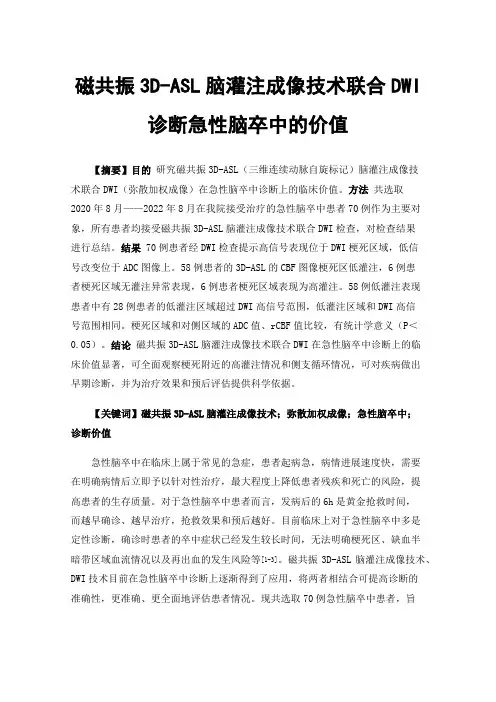
磁共振3D-ASL脑灌注成像技术联合DWI 诊断急性脑卒中的价值【摘要】目的研究磁共振3D-ASL(三维连续动脉自旋标记)脑灌注成像技术联合DWI(弥散加权成像)在急性脑卒中诊断上的临床价值。
方法共选取2020年8月——2022年8月在我院接受治疗的急性脑卒中患者70例作为主要对象,所有患者均接受磁共振3D-ASL脑灌注成像技术联合DWI检查,对检查结果进行总结。
结果 70例患者经DWI检查提示高信号表现位于DWI梗死区域,低信号改变位于ADC图像上。
58例患者的3D-ASL的CBF图像梗死区低灌注,6例患者梗死区域无灌注异常表现,6例患者梗死区域表现为高灌注。
58例低灌注表现患者中有28例患者的低灌注区域超过DWI高信号范围,低灌注区域和DWI高信号范围相同。
梗死区域和对侧区域的ADC值、rCBF值比较,有统计学意义(P<0.05)。
结论磁共振3D-ASL脑灌注成像技术联合DWI在急性脑卒中诊断上的临床价值显著,可全面观察梗死附近的高灌注情况和侧支循环情况,可对疾病做出早期诊断,并为治疗效果和预后评估提供科学依据。
【关键词】磁共振3D-ASL脑灌注成像技术;弥散加权成像;急性脑卒中;诊断价值急性脑卒中在临床上属于常见的急症,患者起病急,病情进展速度快,需要在明确病情后立即予以针对性治疗,最大程度上降低患者残疾和死亡的风险,提高患者的生存质量。
对于急性脑卒中患者而言,发病后的6h是黄金抢救时间,而越早确诊、越早治疗,抢救效果和预后越好。
目前临床上对于急性脑卒中多是定性诊断,确诊时患者的卒中症状已经发生较长时间,无法明确梗死区、缺血半暗带区域血流情况以及再出血的发生风险等[1-3]。
磁共振3D-ASL脑灌注成像技术、DWI技术目前在急性脑卒中诊断上逐渐得到了应用,将两者相结合可提高诊断的准确性,更准确、更全面地评估患者情况。
现共选取70例急性脑卒中患者,旨在进一步探究和评价磁共振3D-ASL脑灌注成像技术联合DWI的临床价值,汇总如下。
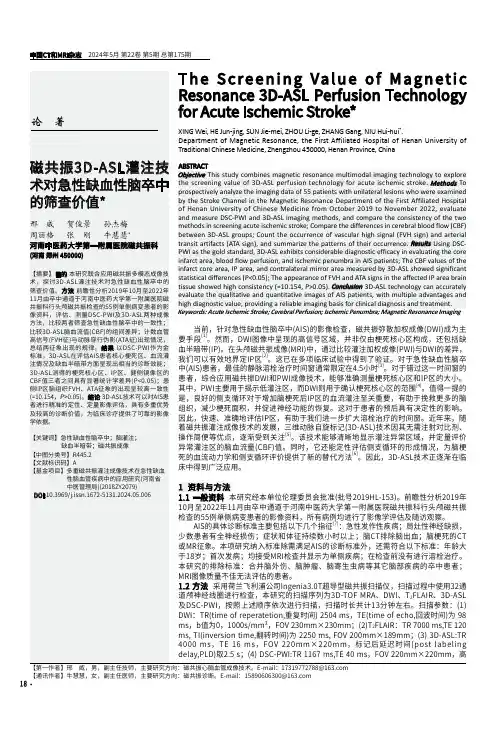
18·中国CT和MRI杂志 2024年5月 第22卷 第5期 总第175期【通讯作者】牛慧慧,女,副主任医师,主要研究方向:磁共振诊断。
E-mail:158****************T h e·19CHINESE JOURNAL OF CT AND MRI, MAY. 2024, Vol.22, No.5 Total No.175压团注Gd-DTPA 0.2mmoL/kg体质量,(4.0~5.0)mL/s;以上各序列层厚均为6mm,层间距为1.0mm。
(5)3D-TOF MRA:TR22 ms,TE3.5 ms,层厚为1.6mm,FOV 200mm×189mm。
1.3 图像分析及后处理 记录3D-TOF MRA、T 2FLAIR、DWI、3D-ASL及DSC-PWI的影像表现,根据北美症状性颈动脉内膜切除实验狭窄分级法((NASCET)[8]来判断MRA图像血管狭窄的情况,在T2 FLAIR序列中若存在液体翻转恢复序列血管高信号(FLAIR vascular hyperintensities,FVH)征象需予以记录,该征象的主要表现为在FLAIR序列中患者的大脑半球脑沟、裂内存在点状、线状或蛇纹状高信号,该影像改变呈连续性出现(≥2个层面)或同一层面上≥2处。
DWI图像上扩散受限区域定义为梗死核心区,由低年资医师手动勾画扩散受限区并测量其范围。
将3D-ASL和DSC-PWI的原始数据传送到ADW4.3工作站,并使用Func-tool软件后处理得到全脑血流量(cerebral blood flow,PWI-CBF)图,包括DSC-CBF、3D-ASL-CBF,确定3D-ASL及DSC-PWI异常灌注区范围。
对比DWI异常信号区、DSC及3D-ASL异常灌注区范围大小,判断梗死核心区及IP区[7],同时会对异常灌注区及其对称健侧区的CBF值进行测量,健侧的ROI以颅脑中线为轴镜面复制,最终取三次测量结果的均值。
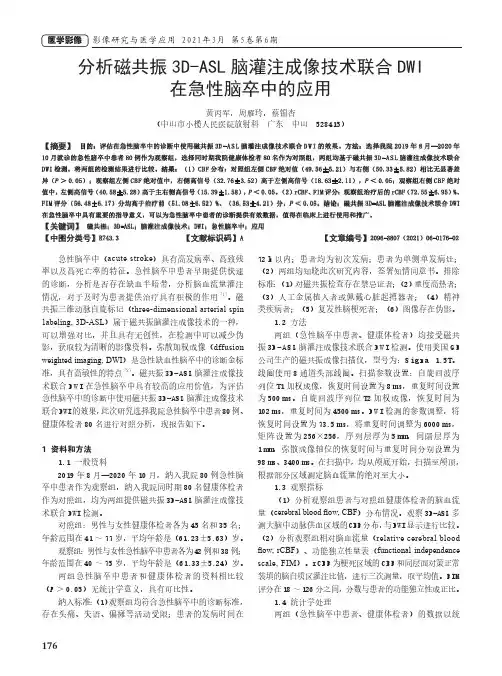
176 影像研究与医学应用 2021年3月 第5卷第6期急性脑卒中(acute stroke)具有高发病率、高致残率以及高死亡率的特征。
急性脑卒中患者早期提供快速的诊断,分析是否存在缺血半暗带,分析脑血流量灌注情况,对于及时为患者提供治疗具有积极的作用[1]。
磁共振三维动脉自旋标记(three-dimensional arterial spin 1abeling, 3D-ASL)属于磁共振脑灌注成像技术的一种,可以增强对比,并且具有无创性,在检测中可以减少伪影,获取较为清晰的影像资料。
弥散加权成像(dffusion weighted imaging, DWI)是急性缺血性脑卒中的诊断金标准,具有高敏性的特点[2]。
磁共振3D-ASL脑灌注成像技术联合D W I在急性脑卒中具有较高的应用价值,为评估急性脑卒中的诊断中使用磁共振3D-ASL脑灌注成像技术联合DWI的效果,此次研究选择我院急性脑卒中患者80例、健康体检者80名进行对照分析,现报告如下。
1 资料和方法1.1 一般资料2019年8月—2020年10月,纳入我院80例急性脑卒中患者作为观察组,纳入我院同时期80名健康体检者作为对照组,均为两组提供磁共振3D-ASL脑灌注成像技术联合DWI检测。
对照组:男性与女性健康体检者各为45名和35名;年龄范围在41~77岁,平均年龄是(61.23±5.63)岁。
观察组:男性与女性急性脑卒中患者各为42例和38例;年龄范围在40~75岁,平均年龄是(61.33±5.24)岁。
两组急性脑卒中患者和健康体检者的资料相比较(P>0.05)无统计学意义,具有可比性。
纳入标准:(1)观察组均符合急性脑卒中的诊断标准,存在头痛、失语、偏瘫等活动受限;患者的发病时间在72 h以内;患者均为初次发病;患者为单侧单发病灶;(2)两组均知晓此次研究内容,签署知情同意书。
排除标准:(1)对磁共振检查存在禁忌证者;(2)重度高热者;(3)人工金属植入者或佩戴心脏起搏器者;(4)精神类疾病者;(5)复发性脑梗死者;(6)图像存在伪影。
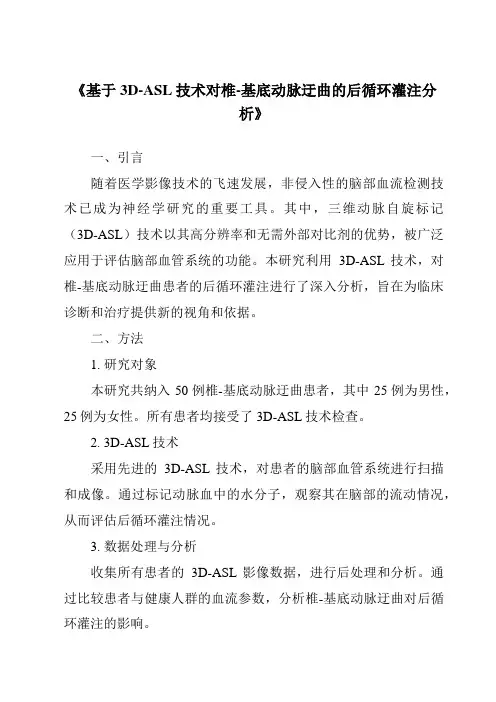
《基于3D-ASL技术对椎-基底动脉迂曲的后循环灌注分析》一、引言随着医学影像技术的飞速发展,非侵入性的脑部血流检测技术已成为神经学研究的重要工具。
其中,三维动脉自旋标记(3D-ASL)技术以其高分辨率和无需外部对比剂的优势,被广泛应用于评估脑部血管系统的功能。
本研究利用3D-ASL技术,对椎-基底动脉迂曲患者的后循环灌注进行了深入分析,旨在为临床诊断和治疗提供新的视角和依据。
二、方法1. 研究对象本研究共纳入50例椎-基底动脉迂曲患者,其中25例为男性,25例为女性。
所有患者均接受了3D-ASL技术检查。
2. 3D-ASL技术采用先进的3D-ASL技术,对患者的脑部血管系统进行扫描和成像。
通过标记动脉血中的水分子,观察其在脑部的流动情况,从而评估后循环灌注情况。
3. 数据处理与分析收集所有患者的3D-ASL影像数据,进行后处理和分析。
通过比较患者与健康人群的血流参数,分析椎-基底动脉迂曲对后循环灌注的影响。
三、结果1. 后循环灌注特点研究发现,椎-基底动脉迂曲患者的后循环灌注与健康人群存在显著差异。
在3D-ASL影像中,患者的脑部血流分布不均,部分区域的血流明显减少。
2. 血流参数分析通过比较患者与健康人群的血流参数,发现椎-基底动脉迂曲患者的平均血流速度、血流量等参数均有所降低。
其中,基底动脉的血流变化最为明显。
四、讨论椎-基底动脉迂曲是一种常见的脑血管病变,可能导致脑部供血不足,引发一系列神经症状。
本研究利用3D-ASL技术,对患者的后循环灌注进行了详细分析,发现椎-基底动脉迂曲对后循环灌注具有显著影响。
这为临床诊断和治疗提供了新的视角和依据。
首先,通过3D-ASL技术,我们可以更准确地评估椎-基底动脉迂曲患者的脑部血流情况。
这有助于医生及时发现供血不足等异常情况,为患者制定个性化的治疗方案提供依据。
其次,通过对血流参数的分析,我们可以更深入地了解椎-基底动脉迂曲对后循环灌注的影响。
这有助于我们更好地理解椎-基底动脉迂曲的发病机制和病程发展,为预防和治疗提供新的思路和方法。
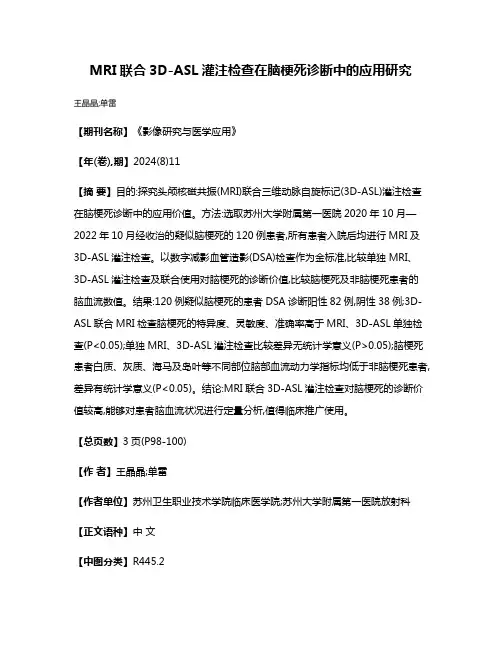
MRI联合3D-ASL灌注检查在脑梗死诊断中的应用研究王晶晶;单雷【期刊名称】《影像研究与医学应用》【年(卷),期】2024(8)11【摘要】目的:探究头颅核磁共振(MRI)联合三维动脉自旋标记(3D-ASL)灌注检查在脑梗死诊断中的应用价值。
方法:选取苏州大学附属第一医院2020年10月—2022年10月经收治的疑似脑梗死的120例患者,所有患者入院后均进行MRI及3D-ASL灌注检查。
以数字减影血管造影(DSA)检查作为金标准,比较单独MRI、3D-ASL灌注检查及联合使用对脑梗死的诊断价值,比较脑梗死及非脑梗死患者的脑血流数值。
结果:120例疑似脑梗死的患者DSA诊断阳性82例,阴性38例;3D-ASL联合MRI检查脑梗死的特异度、灵敏度、准确率高于MRI、3D-ASL单独检查(P<0.05);单独MRI、3D-ASL灌注检查比较差异无统计学意义(P>0.05);脑梗死患者白质、灰质、海马及岛叶等不同部位脑部血流动力学指标均低于非脑梗死患者,差异有统计学意义(P<0.05)。
结论:MRI联合3D-ASL灌注检查对脑梗死的诊断价值较高,能够对患者脑血流状况进行定量分析,值得临床推广使用。
【总页数】3页(P98-100)【作者】王晶晶;单雷【作者单位】苏州卫生职业技术学院临床医学院;苏州大学附属第一医院放射科【正文语种】中文【中图分类】R445.2【相关文献】1.多层螺旋CT联合MRI检查在脑梗死合并脑出血诊断中的应用2.3D-ASL灌注成像与静息态功能MRI在癫痫诊断及鉴别中的价值3.MRI 3D-ASL灌注扫描在短暂性脑缺血诊断中的价值4.双时相3D-ASL、DWI与DSC-MRI灌注在TIA诊断中的对照研究5.多层螺旋CT联合MRI检查在脑梗死合并脑出血诊断中的应用分析因版权原因,仅展示原文概要,查看原文内容请购买。
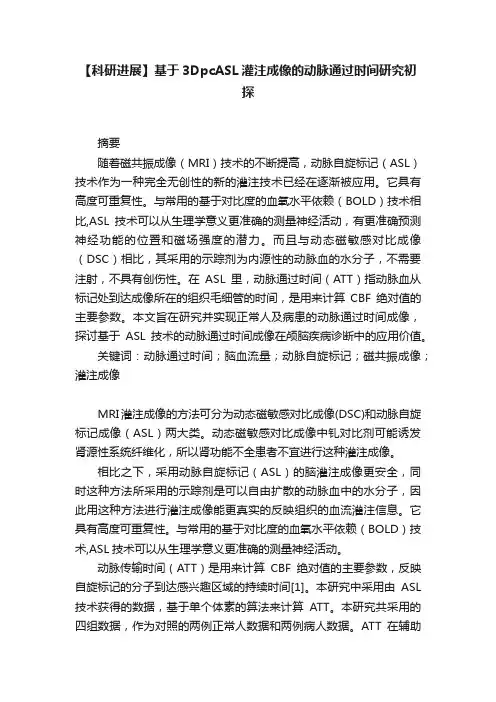
【科研进展】基于3DpcASL灌注成像的动脉通过时间研究初探摘要随着磁共振成像(MRI)技术的不断提高,动脉自旋标记(ASL)技术作为一种完全无创性的新的灌注技术已经在逐渐被应用。
它具有高度可重复性。
与常用的基于对比度的血氧水平依赖(BOLD)技术相比,ASL技术可以从生理学意义更准确的测量神经活动,有更准确预测神经功能的位置和磁场强度的潜力。
而且与动态磁敏感对比成像(DSC)相比,其采用的示踪剂为内源性的动脉血的水分子,不需要注射,不具有创伤性。
在ASL里,动脉通过时间(ATT)指动脉血从标记处到达成像所在的组织毛细管的时间,是用来计算CBF绝对值的主要参数。
本文旨在研究并实现正常人及病患的动脉通过时间成像,探讨基于ASL技术的动脉通过时间成像在颅脑疾病诊断中的应用价值。
关键词:动脉通过时间;脑血流量;动脉自旋标记;磁共振成像;灌注成像MRI灌注成像的方法可分为动态磁敏感对比成像(DSC)和动脉自旋标记成像(ASL)两大类。
动态磁敏感对比成像中钆对比剂可能诱发肾源性系统纤维化,所以肾功能不全患者不宜进行这种灌注成像。
相比之下,采用动脉自旋标记(ASL)的脑灌注成像更安全,同时这种方法所采用的示踪剂是可以自由扩散的动脉血中的水分子,因此用这种方法进行灌注成像能更真实的反映组织的血流灌注信息。
它具有高度可重复性。
与常用的基于对比度的血氧水平依赖(BOLD)技术,ASL技术可以从生理学意义更准确的测量神经活动。
动脉传输时间(ATT)是用来计算CBF绝对值的主要参数,反映自旋标记的分子到达感兴趣区域的持续时间[1]。
本研究中采用由ASL 技术获得的数据,基于单个体素的算法来计算ATT。
本研究共采用的四组数据,作为对照的两例正常人数据和两例病人数据。
ATT在辅助CBF进行脑血管疾病及脑肿瘤鉴别诊断有着重要意义。
灌注是指血液通过毛细血管床与组织进行氧和养分及代谢物交换的过程,定义为每单位时间内对单位质量的人体组织的血液输送量,单位为ml/100g/min[3]。
·1CHINESE JOURNAL OF CT AND MRI, DEC. 2023, Vol.21, No.12 Total No.170【通讯作者】陈 东,男,主任医师,主要研究方向:儿科学影像诊断。
E-mail:*****************between 3D-ASL Perfusion2·中国CT和MRI杂志 2023年12月 第21卷 第12期 总第170期色。
然后分别测量位置尽可能一致ROI的ADC、rCBF值。
1.4 统计学处理 所得足月新生儿HIE的CBF及ADC值均采用 SPSS 19.0及GraphPad Prism 8软件进行统计分析,计量资料以(χ-±s)表示;Pearson相关分析对各ROI的rCBF值与ADC值的相关性进行统计分析,以P <0.05为差异有统计学意义。
2 结 果 足月新生儿HIE各ROI脑区的rCBF值与ADC值相关性分析结果见表1,其中双侧丘脑、双侧顶叶白质、双侧基底节区rCBF值与ADC值呈负相关;双侧额叶白质、双侧小脑半球、小脑蚓部的rCBF值与ADC值无相关性。
3 讨 论 长期以来,CT及常规 MRI 作为HIE的首选检查手段,但由于其基于密度、信号及肉眼可辨的形态学改变,早期诊断敏感性差,定性评价髓鞘化进程缺乏量化指标[8-9]。
阻断单侧颈内动脉1~2小时甚至20分钟之内的大鼠HIE实验模型显示,此时脑细胞性水肿所致的弥散受限表现为DWI高信号、ADC图低信号改变,而普通MRI的T 2WI信号未出现异常改变[4,10]。
由此提示DWI技术通过分析组织中水分子的扩散运动及相关参数来观察病变,可探测HIE早期细胞毒性水肿所致的弥散受限及敏感地反映细胞内外水分子弥散的组织学特性[11-12]。
而3D-ASL技术则是利用选择性的反转脉冲标记供血动脉中的水质子,当标记的水质子流到毛细血管床和细小静脉水平时与组织中的水质子进行交换,引起组织Tl值或磁化率的变化,这种变化反映了组织局部的血流量(即灌注),此方法用磁化标记的水质子作为内源性对比剂,具有无创性、可重复性高及组织对比度较好的优点[13]。
脑ASL灌注成像:临床应用方兴未艾Arterial Spin Labeling Perfusion of the Brain: Emerging Clinical ApplicationsAuthors ListSven Haller, MD, MScGreg Zaharchuk, MD, PhD,David L. Thomas, PhD,Karl-Olof Lovblad, MD,Frederik Barkhof, MD,Xavier Golay, PhDAdditional InformationFrom Affidea Centre Diagnostique Radiologique de Carouge, Clos de la Fonderie 1, 1227 Carouge, Switzerland (S.H.);Dept of Surgical Sciences, Div of Radiology, Uppsala Univ, Sweden (S.H.);Dept of Neuroradiology, Univ Hosp Freiburg, Germany (S.H.);Faculty of Medicine Univ of Geneva, Switzerland (S.H.);Dept of Radiology, Stanford Univ, Stanford, Calif (G.Z.);Univ College London, Inst of Neurology, London, England (D.L.T., X.G.);Dept of Diagnostic and Interventional Neuroradiology, Geneva Univ Hosps,Switzerland (K.O.L.);Dept of Radiology & Nuclear Medicine and PET Research, VU Univ Medical Ctr, Amsterdam, the Netherlands (F.B.);and Insts of Neurology and Healthcare Engineering, Univ College London, England (F.B.).Address correspondence to S.H. (e-mail:*********************).•Abstract••Full Text••Figures••References••Supplemental Materials••Cited by••PDFArterial spin labeling (ASL) is a magnetic resonance (MR) imaging technique used to assess cerebral blood flow noninvasively by magnetically labeling inflowing blood. In this article, the main labeling techniques, notably pulsed and pseudocontinuous ASL, as well as emerging clinical applications will be reviewed. In dementia, the pattern of hypoperfusion on ASL images closely matches the established patterns of hypometabolism on fluorine 18 fluorodeoxyglucose (FDG) positron emission tomography (PET) images due to the close coupling of perfusion and metabolism in the brain. This suggests that ASL might be considered as an alternative for FDG, reserving PET to be used for the molecular disease-specific amyloid and tau tracers. In stroke, ASL can be used to assess perfusion alterations both in the acute and the chronic phase. In arteriovenous malformations and dural arteriovenous fistulas, ASL is very sensitive to detect even small degrees of shunting. In epilepsy, ASL can be used to assess the epileptogenic focus, bothin peri- and interictal period. In neoplasms, ASL is of particular interest in cases in which gadolinium-based perfusion is contraindicated (eg, allergy, renal impairment) and holds promise in differentiating tumor progression from benign causes of enhancement. Finally, various neurologic and psychiatric diseases including mild traumatic brain injury or posttraumatic stress disorder display alterations on ASL images in the absence of visualized structural changes. In the final part, current limitations and future developments of ASL techniques to improve clinical applicability, such as multiple inversion time ASL sequences to assess alterations of transit time, reproducibility and quantification of cerebral blood flow, and to measure cerebrovascular reserve, will be reviewed.© RSNA, 2016Learning Objectives:After reading the article and taking the test, the reader will be able to:1.■ Describe the technical principles of arterial spin labeling2.■ Discuss the limitations and pitfalls of ASL3.■ Discuss the role of ASL in neurodegenerative and cerebrovascular disease, arteriovenous malformation, epilepsy, neoplasms, and neurologic disorders4.■ Discuss the use of ASL to measure cerebrovascular reserve using a vascular challengeConclusionAlthough ASL has been around for more than 2 decades, it only recently began to make the transition from a research toolto clinical use due to increasing awareness of radiologists and clinicians of its capability and technical improvements that have made this approach more reliable and available as product sequences on MR imaging platforms. For many diseases, including dementia, vascular diseases, neoplasms, and various psychiatric diseases, ASL provides additional and complementary information to that available from structural MR imaging. Current methodological developments aim to increase the robustness and decrease interimager variability of CBF estimation.Essentials1.■ Due to the close link between brain metabolism and perfusion, patterns of fluorine 18 fluorodeoxyglucose PET closely resemble those of arterial spin labeling (ASL).2.■ ASL complements structural information of standard MR imaging in neurocognitive decline and may allow early diagnosis of dementia.3.■ ASL may depict mismatch perfusion in acute stroke and help identify tissue at risk in chronic cerebrovascular disease.4.■ ASL may depict arteriovenous shunting in arteriovenous malformation and fistulas.5.■ ASL may be used to localize the epileptogenic focus in seizure disorders.6.■ In neoplasms, ASL may replace standard gadolinium-enhanced dynamic susceptibility contrast-enhanced imaging, notably in patients with allergies or renal insufficiency or in children.7.■ ASL may help detect subtle functional changes in psychiatric disorders such as posttraumatic stress disorder ormild traumatic brain injury, where standard structural MR imaging typically provides no detectable anomaly.8.■ Emerging new applications of ASL include superselective ASL to map vascular territories and cerebrovascular reserve imaging.9.All Figures10.11.12.Figure 1:13.ASLarterial spin labeling labeling schemes. A, In PASLpulsed ASL, an inversion slab is placed proximal to the imaging volume to label blood in the arterial feeding vessels supplying the brain. The pulse is short (∼10 msec) and all the blood is inverted simultaneously. B, In PCASLpseudocontinuous ASL, the inflowing arterial blood is continuously inverted as itflows through the labeling plane by means of a process known as flow-induced adiabatic inversion. The PCASLpseudocontinuous ASL labeling pulse train is typically applied for a period of approximately 1–2 seconds.14.15.16.17.18.Figure 2:19.Differences in labeling degree of ASLarterial spin labeling bolus for PASLpulsed ASL (left column) and PCASLpseudocontinuous ASL (right column). The top row shows the temporal profile of the bolus (1 = fully inverted; 0 = fully relaxed). Since the PASLpulsed ASL inversion slab is inverted at a single point in time (t = 0 on this graph), all the inflowing arterial blood undergoes the same amount of T1 recovery at all timepoints after this. In PCASLpseudocontinuous ASL, blood is labeled as it flows through the inversion plane and recovers en route to the imaging volume. A–D show the degree of labeling remaining at several time points after the start of labeling (t = 0): A, t = 0; B, t = arterial arrival time (ATT); C, t = bolus duration (τ); D, t = ATT + τ. Color scale represents the range from fully inverted (red) to fully relaxed (blue). It can be seen that the PCASLpseudocontinuous ASL labeling process produces a bolus with a higher overall degree of inversion than does the PASLpulsed ASL, resulting in a higher intrinsic SNRsignal-to-noise ratio for PCASLpseudocontinuous ASL.20.21.22.23.24.Figure 3:25.Example of an underestimation of relative CBFcerebral blood flow (relCBF) in ASLarterial spin labeling due to a proximal vessel stenosis. A, The estimated relative CBFcerebral blood flow based on DSCdynamic susceptibility contrast perfusion is within normal limits. B, In contrast, the relative CBFcerebral blood flow estimated by using a standard single–inflow-time ASLarterial spin labeling sequence demonstrates marked reduction in the left anterior and middle cerebral artery territories. The origin of this discrepancy is the increased perfusion delay, illustrated on, C, DSCdynamic susceptibility contrast-derived delay map, which exactly matches the altered perfusion in ASLarterial spin labeling due to the presence of a high-grade stenosis of the left internalcarotid artery on, D, time-of-flight (TOF) image. The underlying principle is explained in E. The normal perfusion time series of DSCdynamic susceptibility contrast imaging (solid black line) is shifted to the right due to the presence of a proximal vessel stenosis and slower collateral flow (dotted line). DSCdynamic susceptibility contrast imaging acquires an entire time series, this shift in the bolus arrival simply causes a shift of the estimated curve, and the relative CBFcerebral blood flow can be accurately estimated in DSCdynamic susceptibility contrast. In contrast, a single–inflow-time ASLarterial spin labeling sequence with a standard inflow time (indicated by the vertical line) will underestimate the true perfusion simply because it is too early with respect to the peak of the perfusion curve.26.27.28.29.30.Figure 4:31.Examples of dementia. Transverse FDGfluorine 18 fluorodeoxyglucose and ASLarterial spin labeling images of, A, a healthy individual (male; age, 57 years; Mini-Mental State Examination [MMSE] score, 30), B, patient with ADAlzheimer disease (male; age, 52 years; MMSE score, 19), and, C, patient with frontotemporal lobar dementia (female; age, 53 years; MMSE score, 26). Functional images show predominant prefrontal abnormalities in FTD and parietal abnormalities in ADAlzheimer disease. Red color reflects normal metabolism and perfusion.32.33.34.35.36.Figure 5:37.Images in 50-year-old woman presenting with stroke, with 14 hours of right hemiparesis and aphasia, National Institutes of Health Stroke Scale score of 9 at the time of imaging. Patient was later found to have extracranial left internal carotid artery dissection. A, Diffusion-weighted images demonstrate irreversibly damaged tissue within the left caudate and putamen. By using a multidelay ASLarterial spin labeling sequence capable of acquiring both, B, CBFcerebral blood flow and, C, arterial transit time images, a larger region of perfusion abnormality is identified. D, Conventional DSCdynamic susceptibility contrast images show the region of perfusion abnormality (time to the maximum of the residue function) is concordant with the findings on ASLarterial spin labeling images.38.39.40.41.42.Figure 6:43.Example of multidelay ASLarterial spin labeling imaging. A fixed labeling duration of 2000 msec is used, but on subsequent images, different postlabel delays (PLD) ranging from 700 to 3000 msec are used, yielding ASLarterial spinlabeling difference (control label) images as shown in A. From these data, and the use of general kinetic modeling, one can simultaneously measure, B, an arrival-time–corrected CBFcerebral blood flow and, C, the arterial arrival time itself. In this patient, there is near symmetric CBFcerebral blood flow but clear arterial arrival delay in the right hemisphere, as shown by the higher values on the arrival time map.44.45.46.47.48.Figure 7:49.Images in 51-year-old man with exertional headaches and an arteriovenous fistula imaged at 1.5 T. A, T2-weighted images demonstrate very subtle flow voids in the inferior frontal lobe (arrow). B, ASLarterial spin labeling images demonstrate linear high signal intensity (arrows) in the region of the right inferior frontal lobe, which extends to the right cavernous sinus, indicative of an arteriovenous shunt lesion. C, Collapsed and, D, source MR angiographic images confirm the presence of an ethmoid dural fistula (arrow), which was recognized only after theobservation of the abnormal ASLarterial spin labeling signal within the venous structures draining the fistula. This case also demonstrates that while 3 T is preferable to 1.5 T, relevant clinical information can be obtained with ASLarterial spin labeling at 1.5 T.50.51.52.53.54.Figure 8:parison of ASLarterial spin labeling MR imaging and FDGfluorine 18 fluorodeoxyglucose PET in epilepsy. Each column represents imaging studies of a single patient. A, Preoperative axial T1-weighted MR images. B, Raw FDGfluorine 18 fluorodeoxyglucose PET images. C, Raw PASLpulsed ASL CBFcerebral blood flow maps. D, Image fusion of T1-weightedMR imaging and FDGfluorine 18 fluorodeoxyglucose PET. E, Image fusion of T1-weighted MR imaging and PASLpulsed ASL. Arrows indicate regions of focal cortical dysplasia that are epileptogenic. Numbers 1–5 refer to different patients. (Reprinted, with permission, from reference 80.)56.57.58.59.60.Figure 9:61.Images in 78-year-old man with unresectable anaplastic astrocytoma (arrow) (World Health Organization Grade 3), seen on, A, postcontrast T1-weighted and, B, FLAIR images. C, ASLarterial spin labeling image demonstrates increased CBFcerebral blood flow (arrow) in the region of the tumor. D, Increased cerebral blood volume (arrow) is also visibleon bolus DSCdynamic susceptibility contrast image, though it is more difficult to appreciate due to the extensive number of arterial and venous vessels that surround the tumor. The findings of high CBFcerebral blood flow are characteristic of high-grade (grades III and IV) glial neoplasms.62.63.64.65.66.Figure 10:67.A, T2-weighted, B, postcontrast T1-weighted, and C, ASLarterial spin labeling images in a 40-year-old man with von Hippel Lindau disease and multiple hemangioblastomas after multiple prior surgeries. Arrows point to the extremely high CBFcerebral blood flow measured with ASLarterial spin labeling even in very small lesions.68.69.70.71.72.Figure 11:73.Images in 57-year-old man with lung cancer brain metastasis 15 months after resection, radiation, and chemotherapy. A, Axial T1-weighted gadolinium-enhanced image shows a new enhancing lesion, with, B, axial fluid-attenuated inversion recovery image demonstrating extensive vasogenic edema in the region of the resection cavity. C, ASLarterial spin labeling image demonstrates no increase in CBFcerebral blood flow in this region, similar to findings on, D, FDGfluorine 18 fluorodeoxyglucose PET image. These findings were considered to represent radiation necrosis and the patient is being followed serially rather than with re-resection.74.75.76.77.78.Figure 12:79.Images in 29-year-old woman with bilateral Moyamoya disease. Both, A, fluid-attenuated inversion recovery and, B, diffusion-weighted images show evidence of prior infarcts in the deep white matter on the left side. C, Multidelay ASLarterial spin labeling image acquired at baseline shows normal CBFcerebral blood flow in the bilateral anterior circulation. D, However, image obtained 10 minutes after intravenous administration of 1 g of acetazolamide demonstrates the expected CBFcerebral blood flow increase in the posterior circulation but marked reduction in CBFcerebral blood flow in both anterior circulations, compatible with cerebrovascular steal. This finding has been associated with a high risk of subsequent cerebrovascular events and prompted bilateral direct superficial temporal artery-middle cerebral artery bypass.80.81.82.83.84.Figure 13:85.Functional connectivity analysis of ASLarterial spin labeling raw data in 154 healthy elderly control subjects and 66 cases with mild cognitive impairment. Note that for illustrative purposes, the raw ASLarterial spin labeling data were directly analyzed by using tensorial independent component in FSL (/fsl/), an established technique optimized for functional MR imaging analysis. A, Spatial representation of one of the independent components. B, The on-off labeling pattern of the raw ASLarterial spin labeling data is clearly visible on the corresponding temporal representation. Currently ongoing methodological adaptation and optimization to the specific properties of ASL data, such as implementing the known prior knowledge of the on-off time course, will improve the quality of ASL-derived functional connectivity networks.86.选自:87.Arterial Spin Labeling Perfusion of the Brain: Emerging Clinical Applications88.Sven Haller, Greg Zaharchuk, David L. Thomas, Karl-Olof Lovblad, Frederik Barkhof, and Xavier Golay89.Radiology 2016 281:2, 337-356全文见:/doi/full/10.1148/radiol.2016150789。
3D-ASL技术在脑缺血疾病中的临床应用研究林显虹(中山大学附属第七医院,广东 深圳)摘要:目的研究3D-ASL技术在脑缺血疾病中的临床应用。
方法选择脑缺血疾病患者作为本次研究对象,并采用“电脑随机法”将200例脑缺血疾病患者进行分组,主要包括两组,其中观察组实施3D-ASL技术诊断;对照组实施DSC-PWI诊断,分析两组诊断符合率、漏诊率以及误诊率。
结果观察组脑缺血疾病患者诊断符合率95.00%高于对照组,差异有统计学意义(P<0.05)。
两组脑缺血疾病患者误诊率以及漏诊率相比较,观察组脑缺血疾病患者更低,差异有统计学意义(P<0.05)。
结论 3D-ASL技术在脑缺血疾病中具有较高诊断价值,能够将缺血性脑梗死的低灌注状态充分反映出来,为后期治疗提供有利依据。
关键词:3D-ASL技术;脑缺血疾病;临床应用;研究中图分类号:R743 文献标识码:B DOI: 10.19613/ki.1671-3141.2019.57.135本文引用格式:林显虹.3D-ASL技术在脑缺血疾病中的临床应用研究[J].世界最新医学信息文摘,2019,19(57):216,220.0 引言脑缺血疾病在临床具有较大危害性,若治疗不及时,易导致其生命安全受到威胁,故此,早期给予其有效诊断十分必要,能够将病变情况充分显示,进而实施有效治疗[1]。
3D-ASL技术即三维动脉自旋标记成像,该诊断方式为一类磁共振灌注成像新技术,其具有无创性、操作简便、无需注射对比剂等优势,其原理主要是通过磁化标记流入动脉血液,直至标记血液流入人体脑组织后,实施全脑三维快速成像,与非标记成像进行对比,进而对全脑血流量变化进行测量[2]。
本文通过分析两组脑缺血疾病患者的各项情况,总结其诊断效果,具体见下文描述。
1 资料与方法1.1 一般资料以脑缺血疾病患者作为研究对象,收取例数和时间分别为200例、2017年6月至2019年3月;观察组患者100例,对照组患者100例。
《3D ASL技术在诊断前循环单侧脑动脉狭窄后侧支循环中的价值研究》篇一一、引言随着现代医学影像技术的不断发展,精确诊断脑血管疾病显得尤为重要。
前循环单侧脑动脉狭窄是一种常见的脑血管疾病,其诊断对于及时采取有效的治疗措施具有重要价值。
其中,侧支循环的评估是诊断的关键之一。
近年来,三维动脉自旋标记技术(3D ASL, Three-Dimensional Arterial Spin Labeling)在脑血管疾病诊断中逐渐崭露头角。
本研究旨在探讨3D ASL技术在诊断前循环单侧脑动脉狭窄后侧支循环中的价值。
二、方法本研究采用3D ASL技术对前循环单侧脑动脉狭窄患者进行侧支循环评估。
选取了近期收治的50例疑似前循环单侧脑动脉狭窄患者作为研究对象,通过3D ASL技术获取患者的影像数据。
同时,选取了相同数量的健康人群作为对照组。
所有数据均由经验丰富的影像科医生进行分析。
三、3D ASL技术原理及优势3D ASL技术是一种非侵入性的磁共振成像技术,通过标记动脉血中的水分子来检测脑部血流情况。
该技术具有高分辨率、无辐射、无需外源性造影剂等优点,能准确反映脑部血流动力学信息。
在诊断前循环单侧脑动脉狭窄后侧支循环时,3D ASL技术能清晰显示侧支循环的血流情况,为诊断提供有力依据。
四、研究结果通过对比分析,发现3D ASL技术在诊断前循环单侧脑动脉狭窄后侧支循环中具有以下价值:1. 准确评估侧支循环:3D ASL技术能准确显示侧支循环的血流情况,包括血流速度、流向及侧支代偿程度等,为医生提供详细的诊断信息。
2. 早期发现病变:在疾病早期阶段,3D ASL技术即可发现异常的侧支循环表现,有助于早期诊断和治疗。
3. 辅助制定治疗方案:通过分析侧支循环的血流情况,医生可制定针对性的治疗方案,提高治疗效果。
4. 良好的重复性和可操作性:相较于其他影像学检查方法,3D ASL技术具有较好的重复性和可操作性,方便医生进行长期随访和观察。